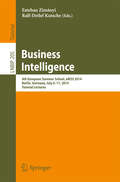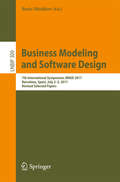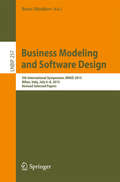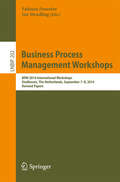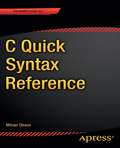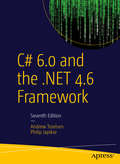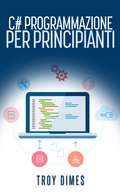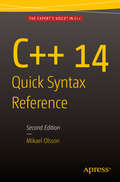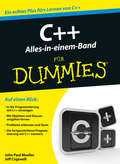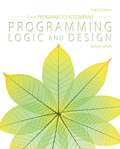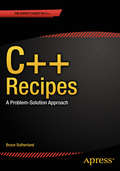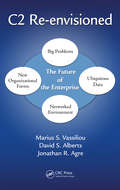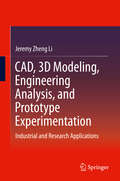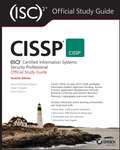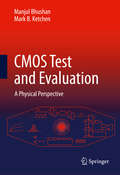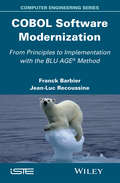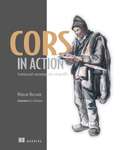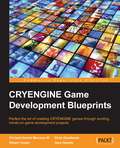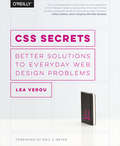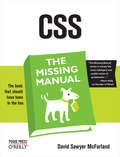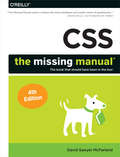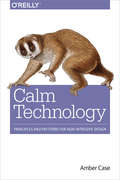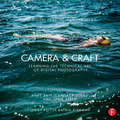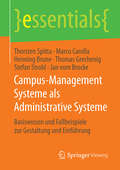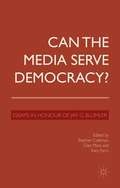- Table View
- List View
Business Intelligence: 4th European Summer School, eBISS 2014, Berlin, Germany, July 6-11, 2014, Tutorial Lectures (Lecture Notes in Business Information Processing #205)
by Esteban Zimányi Ralf-Detlef KutscheThis book constitutes the tutorial lectures of the 4th European Business Intelligence Summer School, eBISS 2014, held in Berlin, Germany, in July 2014. The tutorials presented here in an extended and refined format were given by renowned experts and cover topics including requirements engineering for decision-support systems, visual analytics of large data sets, linked data and semantic technologies, supervised classification on data streams, and knowledge reuse in large organizations.
Business Modeling and Software Design: 4th International Symposium, Bmsd 2014, Luxembourg, Luxembourg, June 24-26, 2014, Revised Selected Papers (Lecture Notes In Business Information Processing #220)
by Boris ShishkovThis book contains revised and extended versions of selected papers from the 7th International Symposium on Business Modeling and Software Design, BMSD 2017, held in Barcelona, Spain, in July 2017. BMSD 2017 received a total of 57 paper submissions. The 10 papers selected for inclusion in this book deal with topics such as: business processes and enterprise engineering; business models and requirements; business models and services; business models and software; information systems architectures and paradigms; and data aspects in business modeling and software development.
Business Modeling and Software Design: 5th International Symposium, BMSD 2015, Milan, Italy, July 6–8, 2015, Revised Selected Papers (Lecture Notes in Business Information Processing #257)
by Boris ShishkovThis book contains the extended and revised versions of selected papers from the 4th International Symposium on Business Modeling and Software Design, BMSD 2014, held in Luxembourg, Luxembourg, in June 2014. The symposium was organized and sponsored by the Interdisciplinary Institute for Collaboration and Research on Enterprise Systems and Technology (IICREST), in collaboration with the Public Research Centre Henri Tudor (TUDOR). Cooperating organizations were the Dutch Research School for Information and Knowledge Systems (SIKS), Aristotle University of Thessaloniki (AUTH), the UTwente Center for Telematics and Information Technology (CTIT), and AMAKOTA Ltd. The 37 papers presented at BMSD 2014 were selected from 52 submissions. The seven papers published in this book were carefully reviewed, selected, revised, and extended from the presented papers. The selection considers a large number of BMSD-relevant research topics: from modeling and simulation-related subjects, such as declarative business rules, business (process) modeling, business process simulation, and information systems modeling, through architectures-related areas, such as impact analysis with regard to enterprise architectures and architectural principles for service cloud applications, to topics touching upon quality-of-service-aware service systems.
Business Process Management Workshops: BPM 2014 International Workshops, Eindhoven, The Netherlands, September 7-8, 2014, Revised Papers (Lecture Notes in Business Information Processing #202)
by Jan Mendling Fabiana FournierThis book constitutes the refereed proceedings of ten international workshops held in Eindhoven, The Netherlands, in conjunction with the 12th International Conference on Business Process Management, BPM 2014, in September 2014. The ten workshops comprised Process-oriented Information Systems in Healthcare (ProHealth 2014), Security in Business Processes (SBP 2014), Process Model Collections: Management and Reuse (PMC-MR 2014), Business Processes in Collective Adaptive Systems (BPCAS 2014), Data- and Artifact-centric BPM (DAB 2014), Business Process Intelligence (BPI 2014), Business Process Management in the Cloud (BPMC 2014), Theory and Applications of Process Visualization (TaProViz 2014), Business Process Management and Social Software (BPMS2 2014) and Decision Mining and Modeling for Business Processes (DeMiMoP 2014). The 38 revised full and eight short papers presented were carefully reviewed and selected from 84 submissions. In addition, six short papers resulting from the Doctoral Consortium at BPM 2014 are included in this book.
C Quick Syntax Reference: A Pocket Guide To The Language, Apis And Library
by Mikael OlssonThe C Quick Syntax Reference is a condensed code and syntax reference to the popular C programming language, which has enjoyed some resurgence of late. C's efficiency makes it a popular choice in a wide variety of applications and operating systems with special applicability to, for instance, wearables, game programming, system level programming, embedded device/firmware programming and in Arduino and related electronics hobbies. This book presents the essential C syntax in a well-organized format that can be used as a quick and handy reference. You won't find any technical jargon, bloated samples, drawn out history lessons, or witty stories in this book. What you will find is a language reference that is concise, to the point and highly accessible. The book is packed with useful information and is a must-have for any C programmer. In the C Quick Syntax Reference, you will find: A concise reference to the C language syntax. Short, simple, and focused code examples. A well laid out table of contents and a comprehensive index allowing easy review.
C# 6.0 and the .NET 4.6 Framework
by Philip Japikse Andrew TroelsenThis new 7th edition of Pro C# 6. 0 and the . NET 4. 6 Platform has been completely revised and rewritten to reflect the latest changes to the C# language specification and new advances in the . NET Framework. You'll find new chapters covering all the important new features that make . NET 4. 6 the most comprehensive release yet, including: A Refined ADO. NET Entity Framework Programming Model Numerous IDE and MVVM Enhancements for WPF Desktop Development Numerous updates to the ASP. NET Web APIs This comes on top of award winning coverage of core C# features, both old and new, that have made the previous editions of this book so popular. Readers will gain a solid foundation of object-oriented development techniques, attributes and reflection, generics and collections as well as numerous advanced topics not found in other texts (such as CIL opcodes and emitting dynamic assemblies). The mission of this book is to provide you with a comprehensive foundation in the C# programming language and the core aspects of the . NET platform plus overviews of technologies built on top of C# and . NET (ADO. NET and Entity Framework, Windows Communication Foundation (WCF), Windows Presentation Foundation (WPF), ASP. NET (WebForms, MVC, WebAPI). ). Once you digest the information presented in these chapters, you'll be in a perfect position to apply this knowledge to your specific programming assignments, and you'll be well equipped to explore the . NET universe on your own terms. What You Will Learn: Be the first to understand the . NET 4. 6 platform and C# 6. Discover the ins and outs of the leading . NET technology. Learn from an award-winning author who has been teaching the . NET world since version 1. 0. Find complete coverage of XAML, . NET 4. 6 and Visual Studio 2015 together with discussion of the new Windows Runtime.
C# Programmazione per principianti
by Alessandro Consorti Troy DimesUna delle cose migliori di C# è che è facile da imparare ... soprattutto con questo libro. Descrizione libro Data di pubblicazione: 23 gen 2015 C # è semplice, ma potente. C # è un linguaggio di programmazione orientato agli oggetti semplice e polivalente. Combinate questo con la sua versatilità e l'enorme libreria standard e sarà facile capire perché è un linguaggio di programmazione popolare e rispettato. Creare applicazioni grafiche, applicazioni web based, e altro ancora. Quando si impara a programmare in C# si sarà in grado di sviluppare applicazioni basate su web o applicazioni desktop grafiche. Una delle cose migliori di C# è che è facile da imparare ... soprattutto con questo libro. Ecco solo alcune delle cose che imparerete ... Cos'è un IDE e quale si dovrebbe utilizzare per lo sviluppo di applicazioni C#. Come creare il vostro primo programma. I vari tipi di dati utilizzati in C#. Gli operatori ... aritmetici, relazionali e logici. Come iterare in un insieme di elementi utilizzando 4 diversi tipi di cicli. Metodi per prendere decisioni nel codice. A proposito di programmazione orientata agli oggetti (OOP). Cosa sono gli oggetti e le classi. Tutto su modificatori e metodi. Argomenti avanzati come ereditarietà e polimorfismo. Come creare applicazioni multi-thread per sfruttare più CPU in una sola volta. Altro ... Esercizi di pratica inclusi che aiutano a realizzare codice C# che esegua "click" per voi. Include un esercizio alla fine di ogni capitolo (insieme alla soluzione) in modo da poter mettere in pratica ciò che avete imparato. Ottimo per programmatori che iniziano o quelli che sono nuovi al linguaggio Java. Se non avete mai programmato prima, non preoccupatevi. Questo libro vi guiderà passo per passo nella creazione della vostra prima applicazione software. Se avete qualche esperienza di programmazione
C++ 14 Quick Syntax Reference: Second Edition
by Mikael OlssonThis updated handy quick C++ 14 guide is a condensed code and syntax reference based on the newly updated C++ 14 release of the popular programming language. It presents the essential C++ syntax in a well-organized format that can be used as a handy reference. You won't find any technical jargon, bloated samples, drawn out history lessons, or witty stories in this book. What you will find is a language reference that is concise, to the point and highly accessible. The book is packed with useful information and is a must-have for any C++ programmer. In the C++ 14 Quick Syntax Reference, Second Edition, you will find a concise reference to the C++ 14 language syntax. It has short, simple, and focused code examples. This book includes a well laid out table of contents and a comprehensive index allowing for easy review. What you'll learn How to create a C++ HelloWorld How to compile and run What are C++ variables, operators, pointers and references What are arrays, strings, conditionals, loops and more How to write functions How to work with constructors, inheritance, overridings How to use access levels, static, enum, string and union, and more What are custom conversions, namespaces, constants, and preprocessors How to do event handling What are type conversions, templates, headers, and more Who this book is for This book is a quick, handy pocket syntax reference for experienced C++ programmers, and a concise, easily-digested introduction for other programmers new to C++. Table of Contents 1. HelloWorld 2. Compile and Run 3. Variables 4. Operators 5. Pointers 6. References 7. Arrays 8. String 9. Conditionals 10. Loops 11. Functions 12. Class 13. Constructor 14. Inheritance 15. Overriding 16. Access Levels 17. Static 18. Enum 19. String and Union 20. Operator Overloading 21. Custom Conversions 22. Namespaces 23. Constants 24. Preprocessor 25. Event Handling 26. Type Conversions 27. Templates 28. Headers
C++ Alles in einem Band für Dummies (Für Dummies)
by John Paul Mueller Jeffrey M. CogswellDieses Buch ist für alle, die tief in die C++-Programmierung einsteigen möchten. Dennoch werden keine Programmierkenntnisse vorausgesetzt. John Paul Mueller und Jeff Cogswell erklären Ihnen zunächst, wie Sie C++ installieren. Sie erfahren, was Klassen und Objekte sind, was Sie mit Entwurfsmustern anfangen und wie Sie Ihre Programme debuggen. Aus Anfängern werden Entwickler mit Erfahrung und dann fortgeschrittene Programmierer. Diese finden in diesem Buch Informationen zu dynamischen Arrays, Lambda-Ausdrücken, Streams, UML, der Standardbibliothek, zu Boost und vielem mehr. Alle Codebeispiele des Buchs stehen zum Download zur Verfügung.
C++ Programs to Accompany Programming Logic and Design, Eighth Edition
by Jo Ann SmithAlso known as C++ PAL), the book is designed to provide students with an opportunity to write C++ programs as part of an Introductory Programming Logic course. This textbook assumes no programming language experience and provides the beginning programmer with a guide to writing structured programs and simple object-oriented programs using introductory elements of the popular C++ programming language.
C++ Recipes: A Problem-Solution Approach
by Bruce SutherlandIn this handy reference, you'll find numbers, strings, dates, times, classes, exceptions, streams, flows, pointers and more. Also, you'll see various code samples, templates for C++ algorithms, parallel processing, multithreading and numerical processes. These have many applications including game development, big data analytics, financial engineering and analysis, enterprise applications and more. A wealth of STL templates on function objects, adapters, allocators, and extensions are also available. C++ Recipes: A Problem-Solution Approach is a handy code cookbook reference guide that cover the latest C++ 14 as well as some of the code templates available in the latest Standard Template Library (STL). This is a "must have", contemporary reference for your technical library. What you'll learn How to handle numbers, strings, text, dates and times, and data in general How to implement a variety of C++ algorithms How to handle and use classes, exceptions, streams and flows How to build parallel processing C++ templates How to code for pointers How to leverage the wealth of C++ templates found in the STL, including function objects, adapters, allocators and more How to extend the STL and more Who this book is for This book is for those with at least some experience with C++ and certainly experience with programming in general. Table of Contents 1. Beginning C++ 2. Modern C++ 3. Working with Text 4. Working with Numbers 5. Classes 6. Inheritance 7. The STL Containers 8. The STL Algorithms 9. Templates 10. Memory 11. Concurrency 12. Networking 13. Scripting 14. 3D Graphics Programming
C2 Re-envisioned: The Future of the Enterprise
by Marius S. Vassiliou David S. Alberts Jonathan Russell AgreCommand and Control (C2) is the set of organizational and technical attributes and processes by which an enterprise marshals and employs human, physical, and information resources to solve problems and accomplish missions.C2 Re-envisioned: The Future of the Enterprise identifies four interrelated megatrends that are individually and collectively sh
CAD, 3D Modeling, Engineering Analysis, and Prototype Experimentation: Industrial and Research Applications
by Jeremy Zheng LiThis succinct book focuses on computer aided design (CAD), 3-D modeling, and engineering analysis and the ways they can be applied effectively in research and industrial sectors including aerospace, defense, automotive, and consumer products. These efficient tools, deployed for R&D in the laboratory and the field, perform efficiently three-dimensional modeling of finished products, render complex geometrical product designs, facilitate structural analysis and optimal product design, produce graphic and engineering drawings, and generate production documentation. Written with an eye toward green energy installations and novel manufacturing facilities, this concise volume enables scientific researchers and engineering professionals to learn design techniques, control existing and complex issues, proficiently use CAD tools, visualize technical fundamentals, and gain analytic and technical skills. This book also: · Equips practitioners and researchers to handle powerful tools for engineering design and analysis using many detailed illustrations · Emphasizes important engineering design principles in introducing readers to a range of techniques · Includes tutorials providing readers with appropriate scaffolding to accelerate their learning process · Adopts a product development, cost-consideration perspective through the book's many examples
CISSP: Certified Information Systems Security Professional Study Guide (Sybex Serious Skills Ser.)
by Darril Gibson Mike Chapple James M. StewartCISSP Study Guide - fully updated for the 2015 CISSP Body of Knowledge CISSP (ISC)2 Certified Information Systems Security Professional Official Study Guide, 7th Edition has been completely updated for the latest 2015 CISSP Body of Knowledge. This bestselling Sybex study guide covers 100% of all exam objectives. You'll prepare for the exam smarter and faster with Sybex thanks to expert content, real-world examples, advice on passing each section of the exam, access to the Sybex online interactive learning environment, and much more. Reinforce what you've learned with key topic exam essentials and chapter review questions. Along with the book, you also get access to Sybex's superior online interactive learning environment that includes: Four unique 250 question practice exams to help you identify where you need to study more. Get more than 90 percent of the answers correct, and you're ready to take the certification exam. More than 1,000 Electronic Flashcards to reinforce your learning and give you last-minute test prep before the exam A searchable glossary in PDF to give you instant access to the key terms you need to know for the exam Coverage of all of the exam topics in the book means you'll be ready for: Security and Risk Management Asset Security Security Engineering Communication and Network Security Identity and Access Management Security Assessment and Testing Security Operations Software Development Security
CMOS Test and Evaluation: A Physical Perspective
by Mark B. Ketchen Manjul BhushanCMOS Test and Evaluation: A Physical Perspective is a single source for an integrated view of test and data analysis methodology for CMOS products, covering circuit sensitivities to MOSFET characteristics, impact of silicon technology process variability, applications of embedded test structures and sensors, product yield, and reliability over the lifetime of the product. This book also covers statistical data analysis and visualization techniques, test equipment and CMOS product specifications, and examines product behavior over its full voltage, temperature and frequency range.
COBOL Software Modernization
by Jean-Luc Recoussine Franck BarbierNowadays, billions of lines of code are in the COBOL programming language. This book is an analysis, a diagnosis, a strategy, a MDD method and a tool to transform legacy COBOL into modernized applications that comply with Internet computing, Service-Oriented Architecture (SOA) and the Cloud. It serves as a blueprint for those in charge of finding solutions to this considerable challenge.
CORS in Action: Creating and consuming cross-origin APIs
by Monsur HossainSummaryCORS in Action introduces Cross-Origin Resource Sharing (CORS) from both the server and the client perspective. It starts with the basics: how to make CORS requests and how to implement CORS on the server. It then explores key details such as performance, debugging, and security. API authors will learn how CORS opens their APIs to a wider range of users. JavaScript developers will find valuable techniques for building rich web apps that can take advantage of APIs hosted anywhere. The techniques described in this book are especially applicable to mobile environments, where browsers are guaranteed to support CORS. Purchase of the print book includes a free eBook in PDF, Kindle, and ePub formats from Manning Publications. About the BookSuppose you need to share some JSON data with another application or service. If everything is hosted on one domain, it's a snap. But if the data is on another domain, the browser's "same-origin" policy stops you cold. CORS is a new web standard that enables safe cross-domain access without complex server-side code. Mastering CORS makes it possible for web and mobile applications to share data simply and securely. CORS in Action introduces CORS from both the server and the client perspective. It starts with making and enabling CORS requests and then explores performance, debugging, and security. You'll learn to build apps that can take advantage of APIs hosted anywhere and how to write APIs that expand your products to a wider range of users. For web developers comfortable with JavaScript. No experience with CORS is assumed.What's InsideCORS from the ground upServing and consuming cross-domain dataBest practices for building CORS APIsWhen to use CORS alternatives like JSON-P and proxiesAbout the AuthorMonsur Hossain is an engineer at Google who has worked on API-related projects such as the Google JavaScript Client, the APIs Discovery Service, and CORS support for Google APIs.Table of ContentsPART 1 INTRODUCING CORSThe Core of CORSMaking CORS requestsPART 2 CORS ON THE SERVERHandling CORS requestsHandling preflight requestsCookies and response headersBest practicesPART 3 DEBUGGING CORS REQUESTSDebugging CORS requests APPENDIXESCORS referenceConfiguring your environmentWhat is CSRF?Other cross-origin techniques
CRYENGINE Game Development Blueprints
by Richard Gerard Marcoux III Chris GoodswenPerfect the art of creating CRYENGINE games through exciting, hands-on game development projects About This Book * Create CRYENGINE games from scratch with CRYENGINE Blank Game Starter-kit * Discover good working practices and tips to quickly jump into making a new level in the game * Build practical game projects and discover advanced concepts of CRYENGINE game development using the examples in the book Who This Book Is For This book is intended for CRYENGINE game developers, wanting to develop their skills with the help of industry experts. A good knowledge level and understanding of CRYENGINE is assumed, to allow efficient programming of core elements and applications. What You Will Learn * Create a CRYENGINE game from scratch with the Game Starter-kit * Add custom methods to allow the player/AI to use a weapon * Create complete "start" and "end" game menus using Scaleform and C++ * Discover how to use highpoly modeling workflow and techniques within the pipeline for the SDK to use * Use the Crytiff exporter from Photoshop * Export the CHR--the format the engine needs to read the skeleton * Integrate the character in the engine using the character tool * Better understand the rules to create and author skeletons to rig characters designed for CRYENGINE * Debug common setup issues that might appear during production with useful tools In Detail CRYENGINE is a game engine developed by Crytek for PC, Playstation, Xbox, Android, and iOS. It can be used to create AAA games, movies, high-quality simulations, and interactive applications. It is most popularly used for game development. In this book, you will start off by exploring the CRYENGINE "Blank" Game Starter-kit, creating a completely playable character from scratch and controlling its movement. You will learn how to implement a weapon and ammo class, and will create complete "start" and "end" game menus using Scaleform and C++. Additionally, you will learn some key texturing techniques for PBR and how to create and bake maps to the lowpoly model. You will also explore how to get a static model from Maya and shaders setbup in the SDK to check the textures during creation, and create all the necessary engine files to export and see the game character's animations in your engine. In the final third of the book, you will learn how to create objectives, set up saved games, layer on audio polish to help immerse the player in the experience, and debug game issues. Style and approach An easy-to-follow, practical guide covering three exciting projects. As you work through each project you will explore new topics including complex animation, advanced scripting, and complex character motion. All the code used in each project is explained in detail.
CSS Secrets: Better Solutions to Everyday Web Design Problems
by Lea VerouIn this practical guide, CSS expert Lea Verou provides 47 undocumented techniques and tips to help intermediate-to advanced CSS developers devise elegant solutions to a wide range of everyday web design problems.Rather than focus on design, CSS Secrets shows you how to solve problems with code. You'll learn how to apply Lea's analytical approach to practically every CSS problem you face to attain DRY, maintainable, flexible, lightweight, and standards-compliant results.Inspired by her popular talks at over 60 international web development conferences, Lea Verou provides a wealth of information for topics including:Backgrounds and BordersShapesVisual EffectsTypographyUser ExperienceStructure and LayoutTransitions and Animations
CSS: The Missing Manual
by David Sawyer McFarlandWeb site design has grown up. Unlike the old days, when designers cobbled togetherchunky HTML, bandwidth-hogging graphics, and a prayer to make their sites look good,Cascading Style Sheets (CSS) now lets your inner designer come out and play. But CSSisn't just a tool to pretty up your site; it's a reliable method for handling allkinds of presentation--from fonts and colors to page layout. CSS: The MissingManual clearly explains this powerful design language and how you can use it tobuild sparklingly new Web sites or refurbish old sites that are ready for an upgrade.Like their counterparts in print page-layout programs, style sheets allowdesigners to apply typographic styles, graphic enhancements, and precise layoutinstructions to elements on a Web page. Unfortunately, due to CSS's complexity andthe many challenges of building pages that work in all Web browsers, most Web authorstreat CSS as a kind of window-dressing to spruce up the appearance of their sites.Integrating CSS with a site's underlying HTML is hard work, and often frustratinglycomplicated. As a result many of the most powerful features of CSS are left untapped.With this book, beginners and Web-building veterans alike can learn how to navigatethe ins-and-outs of CSS and take complete control over their Web pages'appearance.Author David McFarland (the bestselling author of O'Reilly's Dreamweaver: TheMissing Manual) combines crystal-clear explanations, real-world examples, a dashof humor, and dozens of step-by-step tutorials to show you ways to design sites withCSS that work consistently across browsers. You'll learn how to:Create HTML that's simpler, uses less code, is search-engine friendly, andworks well with CSSStyle text by changing fonts, colors, font sizes, and adding bordersTurn simple HTML links into complex and attractive navigation bars-completewith CSS-only rollover effects that add interactivity to your Web pagesStyle images to create effective photo galleries and special effects likeCSS-based drop shadowsMake HTML forms look great without a lot of messy HTMLOvercome the most hair-pulling browser bugs so your Web pages work consistentlyfrom browser to browserCreate complex layouts using CSS, including multi-column designs that don'trequire using old techniques like HTML tablesStyle Web pages for printingUnlike competing books, this Missing Manual doesn't assume that everyone in theworld only surfs the Web with Microsoft's Internet Explorer; our book providessupport for all major Web browsers and is one of the first books to thoroughlydocument the newly expanded CSS support in IE7, currently in beta release.Want to learn how to turn humdrum Web sites into destinations that will captureviewers and keep them longer? Pick up CSS: The Missing Manual and learn thereal magic of this tool.
CSS: The Missing Manual (Missing Manual Ser.)
by David Sawyer McFarlandCSS lets you create professional-looking websites, but learning its finer points can be tricky—even for seasoned web developers. This fully updated edition provides the most modern and effective tips, tricks, and tutorial-based instruction on CSS available today. Learn how to use new tools such as Flexbox and Sass to build web pages that look great and run fast on any desktop or mobile device. Ideal for casual and experienced designers alike.The important stuff you need to know:Start with the basics. Write CSS-friendly HTML, including the HTML5 tags recognized by today’s browsers.Design for mobile devices. Create web pages that look great when visitors use them on the go.Make your pages work for you. Add animations that capture the imagination, and forms that get the job done.Take control of page layouts. Use professional design techniques such as floats and positioning.Make your layouts more flexible. Design websites with Flexbox that adjust to different devices and screen sizes.Work more efficiently. Write less CSS code and work with smaller files, using Syntactically Awesome Stylesheets (Sass).
Calm Technology: Principles and Patterns for Non-Intrusive Design
by Amber CaseHow can you design technology that becomes a part of a user’s life and not a distraction from it? This practical book explores the concept of calm technology, a method for smoothly capturing a user’s attention only when necessary, while calmly remaining in the background most of the time. You’ll learn how to design products that work well, launch well, are easy to support, easy to use, and remain unobtrusive.Author Amber Case presents ideas first introduced by researchers at Xerox PARC in 1995, and explains how they apply to our current technology landscape, especially the Internet of Things. This book is ideal for UX and product designers, managers, creative directors, and developers. You’ll learn:The importance and challenge of designing technology that respects our attentionPrinciples of calm design—peripheral attention, context, and ambient awarenessCalm communication patterns—improving attention through a variety of sensesExercises for improving existing products through calm technologyPrinciples and patterns of calm technology for companies and teamsThe origins of calm technology at Xerox PARC
Camera & Craft: (The Digital Imaging Masters Series) (The Digital Imaging Masters Series)
by Andy Batt Candace Dobro Jodie Steen#2 on Photo.net's list of Best Photography Books of 2014! To create successful imagery, you need to balance technical know-how and aesthetic vision. In Camera & Craft, we deconstruct photographic principles in new ways to help you think through your process. Together with nine guest photographers, we explore photographic practice and follow up with inventive exercises and demonstrations that challenge you to engage with your tools—all with the goal of helping you work more creatively. Along the way are conversations with our guest photographers that address each topic, from how the professionals work with clients and models to what they think about as they look through the viewfinder. Here’s what you’ll find inside: Advice and insights from professionals working in a variety of fields, from photojournalism and portraiture to fine-art, landscape and commercial photography Technical explanations about how photographic tools work—so you can connect knowledge to your practice and work more instinctively and creatively Key steps for improving digital workflow Innovative exercises at the end of each chapter as well as on our companion website that encourage you to experiment with and understand the photographic process—from learning how far you can push your camera’s sensor to exploring the effects of neutral vs. creative color Interviews with technical and creative experts about developing skills and making images that matter This book is part of The Digital Imaging Masters Series, which features cutting-edge information from the most sought-after and qualified professionals and instructors in the photography field. Based on the progressive curriculum of the Master of Professional Studies in Digital Photography (MPS DP) program created by Katrin Eismann at the School of Visual Arts (SVA) in New York City, these books are the next best thing to being in the classroom with the Digital Photography Masters themselves.
Campus-Management Systeme als Administrative Systeme: Basiswissen und Fallbeispiele zur Gestaltung und Einführung (essentials)
by Jan Vom Brocke Thorsten Spitta Marco Carolla Henning Brune Thomas Grechenig Stefan StroblDie Autoren vermitteln, was den Softwaretyp Campus-Management ausmacht, welche Funktionen zum Kern eines CMS gehören und welche nicht benötigt werden. Sie skizzieren die Datenbasis solcher Systeme in einem Referenz-Datenmodell. Vertiefend wird dieses Modell im Buch Ein Referenz-Datenmodell für Campus-Management-Systeme in deutschsprachigen Hochschulen (Carolla 2015) empirisch validiert beschrieben. Neben den Charakteristika Administrativer Systeme im Hochschulbereich illustrieren die Autoren die Einführung zweier produktiver CMS, die als Eigenentwicklungen in Bielefeld und Wien entstanden sind.
Can the Media Serve Democracy?
by Stephen Coleman Giles Moss Katy ParryThis landmark collection brings leading scholars in the field of political communication to debate one of the most important questions of our age: Can the media serve democracy? For the media to be democratic, they must enter into a positive relationship with their readers, viewers and listeners as citizens rather than consumers who buy things, audiences who gaze upon spectacles or isolated egos, obsessed with themselves. The media's first task is to remind people that they are inhabitants of a world in which they can make a difference. By enabling citizens to encounter and make sense of events, relationships and cultures of which they have no direct experience, the media constitute a public arena in which members of the public come together as more than passing strangers.
